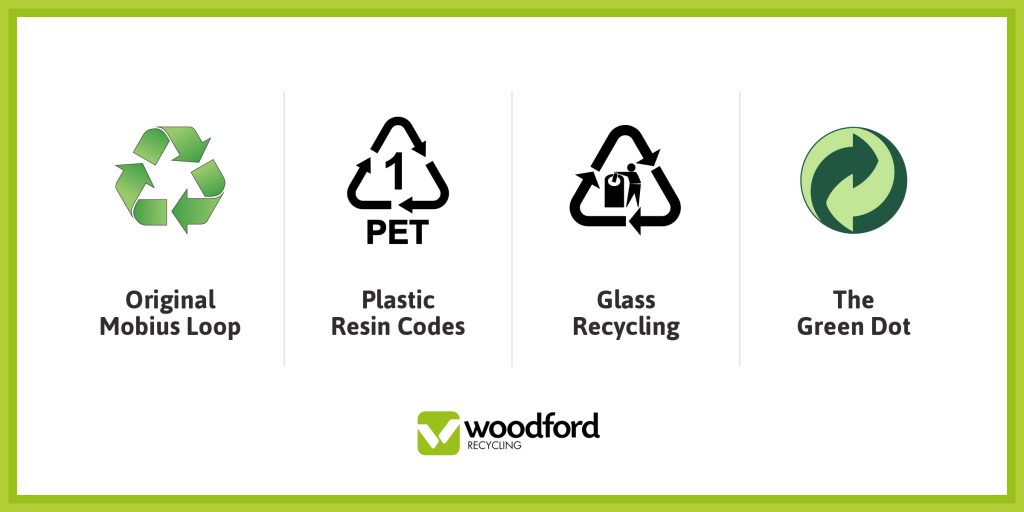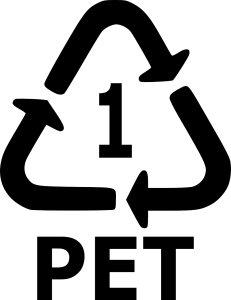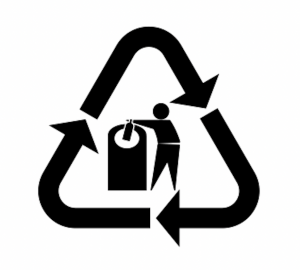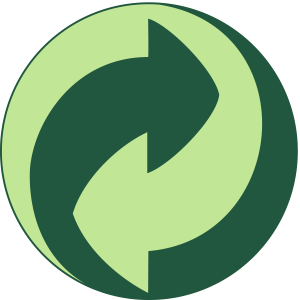Everything You Didn’t Know About the Mobius Loop
The Mobius loop is perhaps one of the most widely recognised recycling symbols in the world. With its three green chasing arrows, it would be easy to assume that anything with this symbol stamped onto it can be recycled everywhere, although this assumption is actually wrong.
In this article, we’ll be telling you all there is to know about the Mobius loop, together with how it came about, what it tells us and what it shouldn’t be confused with.

The history of the Mobius loop
As attention towards environmental issues skyrocketed around the world, leading to the first Earth Day in 1970, the Mobius loop gained huge popularity after a sponsored contest took place throughout America to raise environmental awareness. Gary Anderson, a 23-year-old university student in North Carolina, won the contest with his universal recycling symbol – the Mobius loop.
Despite being in the public domain since the contest was won, the symbol itself isn’t trademarked. This comes after several claims that the design of the Mobius loop had been inspired by other existing recycling symbols at the time. For example, a Volkswagen symbol featuring two chasing arrows had been stamped onto car parts since the 1960’s looked remarkably similar.
However, no solid evidence could be provided to suggest that the design for the Mobius loop had been plagiarised, and so it remains in the public domain to this day and is stamped on millions of products around the world.
What does the Mobius loop tell us?
The Mobius loop is a widely recognised symbol, although its name may not be. The original Mobius loop is presented in the form of a triangle made up of three green arrows that appear to be looping back on themselves. If an item has been stamped with this symbol, then it means the item itself has the potential to be recycled, although the item itself may not be made from recycled materials.
If the item has been made from recycled materials, then the Mobius loop will be accompanied by a percentage, indicating approximately how much of that item has been made using recycled materials. Also, if the item can be recycled, this symbol doesn’t guarantee that it can be recycled by all centres/systems, so you should check locally before placing an item, stamped with a Mobius loop, in the recycling.
According to Recycle Now, the description for the Mobius loop stands as follows: “This indicates that an object is capable of being recycled, not that the object has been recycled or will be accepted in all recycling collection systems. Sometimes this symbol is used with a percentage figure in the middle to explain that the packaging contains x% of recycled material.”
Are there different variations of the Mobius loop?
There are a fair few symbols out there that look somewhat similar to the Mobius loop, however each one means something else and doesn’t necessarily mean that everything with this stamp on it can be recycled. Below are a couple of examples of what the Mobius loop is often mistaken for.
The original Mobius loop
This is the classic, universal recycling symbol telling us that an item is capable of being recycled, although it is not a definitive indication that an item can be recycled or accepted by all recycling centres/systems. Consisting of three green chasing arrows with a blank centre, this is one of the most widely recognised recycling symbols in the world, although it can often be one of the most confusing.

Plastic resin codes
This tells us the type of plastic resin used to manufacture an item. Represented by three chasing arrows surrounding a number which could be between 1 and 7, it may also have ‘PET’ underneath it. Looking very similar to a Mobius loop, the arrows are often more narrow and aren’t coloured green.
You can identify the type of plastic and how it should be recycled based on the number in the centre of the symbol. To learn more about the seven different types of plastics and how they should be responsibly disposed of, visit this website.

Glass
Although made up of three chasing arrows, this symbol looks like a 2D Mobius loop, usually consisting of straight, black arrows as opposed to twisted, green arrows. Unlike the traditional Mobius loop, there will be an image in the middle of a man putting something into a bin.
If you see this stamped on a glass item, then it means the glass can be recycled and so should be disposed of in a dedicated bottle/glass bank. Remember to separate your glass waste into colours and dispose of accordingly. Some local councils may take glass in your kerbside recycling bin, so check locally if you aren’t sure.

Why are recycling symbols so confusing?
According to Recyclingbins.co.uk, a survey carried out by Which? found that nearly half the people they surveyed believed the Green Dot meant that something could be recycled. In reality, the Green Dot simply indicates that the manufacturer has paid a fee to a scheme which supports and carries out the recovery and recycling of certain products.
Out of the 2,155 respondents, 73% could identify the Mobius loop symbol, but didn’t know exactly what the symbol meant, with many believing that it gave consumers the go-ahead to throw the item in the recycling bin.
Why are there so many recycling rules?
For instance, Scotland has 32 different councils, with each one making their own recycling rules, including:
- What can be put in each bin
- The number of bins provided
- The colour of each bin
The reason for this is because each council will have a Material Recovery Facility (MRF), and not every MRF will take the same waste type or sort through it all, making it very confusing for residents in Scotland.
England and Wales are also hit by the same level of confusion, with councils across the country differing on a number of factors, including:
- What materials can be recycled
- How both recyclable and non-recyclable materials are disposed of
- The colour of the bins
- The number of bins provided
- The type of bins provided
A small number of councils don’t offer kerbside recycling bins at all, and so residents are tasked with taking their recyclable rubbish down to their local recycling centre. Although this method is slowly being phased out, it can often leave citizens wondering where they stand when it comes to how they dispose of their waste.
According to the BBC, analysis done on 39 councils throughout the UK showed that, due to the different rules that are laid out, some, but not all councils will collect:
- Bottles
- Pots, tubs and trays
- A variety of recyclable waste in one kerbside bin
Not to be confused with Der Grüne Punkt (The Green Dot)
Instead of being an indication that something can be recycled, The Green Dot is actually a symbol for a series of European industry-funded systems for the “packaging materials of consumer goods”. It should be thought of more as a logo as opposed to a symbol which suggests an item can be recycled. So much so, The Green Dot has been trademarked and protected worldwide.

A concept devised in 1990 by Klaus Töpfer, Germany’s Environment Minister at the time, the Der Grüne Punkt (The Green Dot) lets a consumer know that the manufacturer of the product financially contributes to the recovery and recycling processes. This also helps to fund the system itself, as The Green Dot licence is paid by the product manufacturers as well. Fees will vary based on two factors:
- The country a manufacturer is based in
- The materials used in or for the packaging
Essentially, The Green Dot system encourages manufacturers to reduce the amount of packaging they use, thus reducing their license fee charge and helping the environment. The Green Dot is not clarification that a particular item can be recycled.
How do I know what to recycle locally?
If you aren’t sure what you can recycle, it’s important that you check with your local council as to whether or not a particular item can be recycled. If it cannot be placed in your kerbside recycling bin, then that doesn’t mean to say that it cannot be recycled at all. Check to see whether your local recycling centre/facility will take the items instead, here are a few located in the local area:
- March Waste Recycling Centre
- St Neots Waste Recycling Centre
- PCC Household Waste Recycling Centre (for residents in Peterborough)
- Alconbury Waste Recycling Centre (for residents in Huntingdon)
- Bourne Recycling Centre (for residents in Stamford)
- Bluntisham Recycling Centre (for residents in St Ives)
Woodford Recycling is committed to providing safe, reliable and responsible waste management services to customers living in Cambridge, Peterborough, Huntingdon, Stamford, St Ives and the surrounding areas. If you’re interested in how we aim to recycle 100% of the waste we collect, or to learn more about our recycling services or dedicated recycling facility, get in touch with us today – we’re always happy to help.

